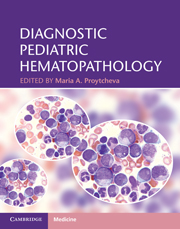Book contents
- Frontmatter
- Contents
- List of contributors
- Acknowledgements
- Introduction
- Section 1 General and non-neoplastic hematopathology
- Section 2 Neoplastic hematopathology
- 10 Chromosome abnormalities of hematologic malignancies
- 11 Expression profiling in pediatric acute leukemias
- 12 Myeloproliferative neoplasms
- 13 Myelodysplastic/myeloproliferative neoplasms
- 14 Myelodysplastic syndromes and therapy-related myeloid neoplasms
- 15 Acute myeloid leukemia and related precursor neoplasms
- 16 Hematologic abnormalities in individuals with Down syndrome
- 17 Precursor lymphoid neoplasms
- 18 Advances in prognostication and treatment of pediatric acute leukemia
- 19 The effect of chemotherapy, detection of minimal residual disease, and hematopoietic stem cell transplantation
- 20 Pediatric small blue cell tumors metastatic to the bone marrow
- 21 Pediatric mature B-cell non-Hodgkin lymphomas
- 22 Pediatric mature T-cell and NK-cell non-Hodgkin lymphomas
- 23 Hodgkin lymphoma
- 24 Immunodeficiency-associated lymphoproliferative disorders
- 25 Histiocytic proliferations in childhood
- 26 Cutaneous and subcutaneous lymphomas in children
- Index
- References
11 - Expression profiling in pediatric acute leukemias
from Section 2 - Neoplastic hematopathology
Published online by Cambridge University Press: 03 May 2011
- Frontmatter
- Contents
- List of contributors
- Acknowledgements
- Introduction
- Section 1 General and non-neoplastic hematopathology
- Section 2 Neoplastic hematopathology
- 10 Chromosome abnormalities of hematologic malignancies
- 11 Expression profiling in pediatric acute leukemias
- 12 Myeloproliferative neoplasms
- 13 Myelodysplastic/myeloproliferative neoplasms
- 14 Myelodysplastic syndromes and therapy-related myeloid neoplasms
- 15 Acute myeloid leukemia and related precursor neoplasms
- 16 Hematologic abnormalities in individuals with Down syndrome
- 17 Precursor lymphoid neoplasms
- 18 Advances in prognostication and treatment of pediatric acute leukemia
- 19 The effect of chemotherapy, detection of minimal residual disease, and hematopoietic stem cell transplantation
- 20 Pediatric small blue cell tumors metastatic to the bone marrow
- 21 Pediatric mature B-cell non-Hodgkin lymphomas
- 22 Pediatric mature T-cell and NK-cell non-Hodgkin lymphomas
- 23 Hodgkin lymphoma
- 24 Immunodeficiency-associated lymphoproliferative disorders
- 25 Histiocytic proliferations in childhood
- 26 Cutaneous and subcutaneous lymphomas in children
- Index
- References
Summary
Introduction
DNA microarrays have proven to be a very powerful research tool. Since the term “DNA microarray” was first introduced in 1995 [1], there have been more than 12 000 publications on this new technology. The anticipated clinical utility has always been implied if not directly stated and it is notable that one of the first proof-of-principle studies to demonstrate clinical utility involved gene expression profiling of pediatric leukemias [2]. Acute leukemias have been ideal for exploring the potential of microarray technology because of the easy accessibility and purity of the neoplastic cells. This, and other early studies, investigated the differential gene expression of leukemia cells as a tool for predicting prognosis and therapy-related toxicity, and for identifying new mechanisms of pathogenesis and potential targets for therapy. Indeed, some investigators have suggested that gene expression microarray of acute leukemia will soon replace the standard diagnostic tools such as morphology, cytogenetics, and flow cytometry, in addition to establishing a molecular classification that would usher in the era of “personalized medicine.” However, despite these early successes and the consequent excitement they generated, some investigators have questioned accuracy and reproducibility of microarray data, arguing that the data are at best a starting point for investigations, and translation to clinical practice will require extensive validation using more established, reproducible technologies. Nevertheless, proponents of the gene expression microarray approach continue to press on with refinements in targets, techniques, and technology, and clinical trials have begun.
- Type
- Chapter
- Information
- Diagnostic Pediatric Hematopathology , pp. 202 - 216Publisher: Cambridge University PressPrint publication year: 2011



